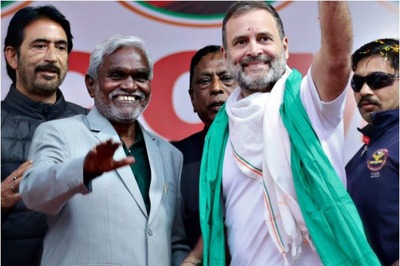
views
Great power competition had been the dominant theme of the past century’s strategic discourse. After the fall of the erstwhile USSR in the early 1990s, followed by a brief but significant unipolar moment for the USA, the world seemed to be moving towards a multipolar order, categorised by a number of powers playing a role. However, in recent years, exacerbated by the global pandemic, great power politics have once again gained traction in the global strategic affairs discourse.
The technology domain has not escaped this trend, witnessing data espionage, foreign influence operations, banning of technology services ranging from apps all the way to the infrastructure domain. Many such trends can be observed in the relationship between the US and the People’s Republic of China (PRC). However, as analysts note, the contemporary form of this competition is inherently different from the great power clash of the previous century.
This piece aims to understand the US-PRC technology conflict through the lens of reflexive games, which refers to attempts by different states aiming to implement reflexive control on one another. This follows-up on an earlier discussion on how warfare has changed and given rise to 6th Generation Warfare (6GW) due to the rise of mass data collection, behavioural/predictive analytics, and AI by firms under the global surveillance capitalism economic system.
From this perspective, the control of user data of foreign, especially hostile states, is a control of global personal data that has become another battleground for great power competition. This is because control of data implies the ability to erode the sovereignty of the target. Reflexive games are played by the two preeminent powers not just for gaining reflexivity vis-à-vis their adversary, but also to gain reflexivity on other states’ governments or citizenry globally, to control the global narrative.
ALSO READ | Kissinger ‘Sold’ American Business to China and Chinese Interests to US Policymakers
State of Global Tech
Under the hierarchy of control, the higher the service, the greater the data collection abilities or data collection restriction abilities. Infrastructure has the ability to gather or restrict the gathering of the maximum amount of data, as demonstrated by the security risk posed by Huawei, or AWS erasing Parler from the face of the internet after the US Capitol violence. These are followed by Operating Systems (OSs), platforms, apps, websites, and plugins, extensions, mods and hacks. In essence, the higher the technology service, the more data it can collect or restrict the collection of data by lower order services.
From this perspective, technology competition, data governance policies, limiting market access, and indigenisation of technology can be seen as attempts to limit the adversary’s reflexivity on the great power in question. Similarly, limiting global access to the adversary’s technology, and the promotion of one’s own technology firms through diplomatic and strategic pressures can be seen as attempts to increase one’s reflexivity vis-à-vis one’s adversary and establish greater control over other states.
However, an inherent contradiction is that technology companies have to serve two roles, in essence, that of a for-profit company, and that of a national security asset. For example, Facebook and Google are assisting the PRC in developing their technological capabilities, despite the PRC being a strategic rival of the US. In this dilemma of serving two masters, the control that states exert over their own technology firms determines whether a rival can exploit the services offered by those very firms to wage influence operations.
High-tech Dance of the Eagle and the Dragon
The US enjoys preeminent power status in the cyber domain. US companies have an overwhelming global presence in critical and fundamental domains such as Hardware, OSs (both mobile and desktop), infrastructure (Cloud, CDNs, web hosting), social platforms, etc. Thus, the US enjoys the maximum reflexivity vis-à-vis the rest of the world. Eleven of the world’s top 20 technology companies are based in the US. The 9 remaining top 20 firms represent the PRC, whose technology firms have also gained a significant presence in higher order domains, especially network infrastructure. Both the great powers have incorporated elements of 6GW and psychological warfare in their respective security strategies. PRC has done this in the form of the ‘three wars’ doctrine and the US in the form of ‘Perception Management’. PRC’s Golden Shield Project (the Great Firewall) enhanced its defence against foreign reflexivity through blocking most of the outside internet.
US control of global personal data is maintained through two mechanisms. First, the largest technology companies, including Microsoft, Apple, Google, and Facebook, are voluntary PRISM programme partners of the NSA. Due to the global presence of PRISM partners, the US has the ability to collect user data at a global scale. The FISA Act authorises communications interception of any foreign person without a judicial order, at the sole approval of the Attorney General. Further, the US can compel non-compliant companies in their jurisdiction to record and release user data through instruments such as the National Security Letters.
ALSO READ | India Must Regulate Tech Giants, Even If It Erodes Bottom Lines of Powerful Vested Interests
PRC’s companies have also begun providing services beyond its borders. PRC’s National Intelligence Law (NIL) functions in a similar manner to the PRISM programme; however, unlike the US, it seeks to resolve the two masters dilemma through compelling all PRC companies to assist in state intelligence operations. Similarly, the cybersecurity law enforced strict localisation requirements, with any foreign transfer of data requiring the consent of the cybersecurity administration. Similar to the PRISM programme, this legislation required all companies operating in the PRC to share user data with the government. These provisions significantly reduce any opponent’s reflexivity vis-à-vis the PRC.
Secondly, the US’ alliance systems play a crucial role in its strategy for global mass data surveillance dominance. The ‘Five Eyes’, ‘Nine Eyes’ and ‘Fourteen Eyes’ intelligence-sharing alliances allow US intelligence agencies to not only harness data from its allies and the data they have access to, but also allows for these agencies to circumvent US laws and privacy protections to access private data of its own citizens. In addition, these alliances have also been used for running “a global system for the interception of private and commercial communications”, such as Project Echelon, granting the US great reflexivity vis-à-vis the rest of the world.
Unlike the US, PRC is not relying on alliances for challenging the US’ global surveillance data hegemony, but is relying on the Digital Silk Road initiative, under which PRC’s technology services are provided to the participating states, including the highest order of technology services such as telecommunications infrastructure. This grants the PRC great reflexivity upon the participating countries.
Huawei’s crucial position in the 5G market globally opened a domain where the US did not enjoy dominance, and with increasing adoption of Huawei in the US domestic market, US faced increasing PRC reflexivity leading to the ban on Huawei. However, the US also used the threat as an opportunity to enhance its reflexivity vis-à-vis the rest of the world. Calling for a global ban on Huawei 5G infrastructure, the alternatives suggested by the US to the world to replace Huawei, i.e., Ericsson, is based in Sweden, a Fourteen Eyes ally of the US. In essence, the world adopting Ericsson would not only limit US’ strategic competitor; in essence, it would limit China’s ability to gain global data control but would also provide the US greater control of global data.
The ban also led to Huawei developing its own OS, thus, reducing PRC’s dependence on the US for the OS domain and reducing US reflexivity vis-à-vis the PRC. In fact, PRC companies have consistently seen openings to increase global reflexivity such as with Kai OS, the newest and most used OS for ‘dumb’ phones, even US tech giants like Google have invested in this venture as it caters to a market/price segment currently not serviced by Android. The OS has quickly become the third major global OS, with a user base of 100 million in 2020 and expanding. This implied the PRC gained market share in a higher order domain previously dominated by the US, thus, furthering the PRC’s superpower ambitions.
A Way Forward for India
While in the short to medium term, India is constrained strategically by the threat posed by the PRC, and, thus, must rely on US tech, however; in the long run, India must decide whether it sees itself as a potential superpower or is content with being a US ally. Being the only member of the Quad that is not a part of the US-led ‘Five Eyes’ intelligence-sharing alliance, India is in a peculiar position to decide its place in the evolving world.
While joining such intelligence alliances would help India reduce its dependency on PRC technology and would allow for India to reduce PRC’s reflexivity, it would come at the cost of reliance on the US. However, in the long term, hedging its bets on the US and developing domestic alternatives might keep the option of superpower ambitions open for India.
Further, the limited number of domestic alternatives developed by India should be promoted abroad through programmes similar to the US’ PRISM or PRC’s NIL if India has great power ambitions and hopes to someday assert control within the global data surveillance landscape.
This article was first published on ORF.
Read all minute-by-minute news updates for Uttar Pradesh election results 2022, Punjab election results 2022, Uttarakhand election results 2022, Manipur election results 2022, and Goa election results 2022.
Click here for seat-wise LIVE result updates.




















Comments
0 comment